Appendix M: Infectious Disease Information
Kelly McKown
Infectious Disease Information
Bronchitis (Chest Cold)
A chest cold occurs when the airways of the lungs swell and produce mucus in the lungs. That’s what produces the cough. A chest cold, often called acute bronchitis, lasts less than 3 weeks and is the most common type of bronchitis.

Acute bronchitis is usually caused by a virus and often occurs after an upper respiratory infection. Bacteria can sometimes cause acute bronchitis, but even in these cases, antibiotics are NOT recommended and will not help an infected person get better.
Symptoms of acute bronchitis last less than 3 weeks and can include:
- Coughing with or without mucus
- Soreness in the chest
- Feeling tired (fatigue)
- Mild headache
- Mild body aches
- Sore throat[2]
Most chest colds will get better on their own within one week and are not cause for exclusion from child care.
Chickenpox
Chickenpox is a highly contagious disease caused by the varicella-zoster virus (VZV). It can cause an itchy, blister-like rash. The rash first appears on the chest, back, and face, and then spreads over the entire body, causing between 250 and 500 itchy blisters. Chickenpox can be serious, especially in babies, adolescents, adults, pregnant women, and people with a weakened immune system. The best way to prevent chickenpox is to get the chickenpox vaccine.[3]
The classic symptom of chickenpox is a rash that turns into itchy, fluid-filled blisters that eventually turn into scabs. The rash may first show up on the chest, back, and face, and then spread over the entire body, including inside the mouth, eyelids, or genital area. It usually takes about one week for all of the blisters to become scabs.
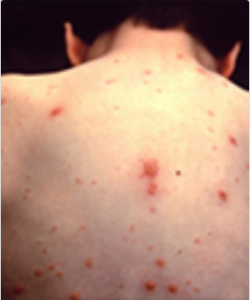
Other typical symptoms that may begin to appear 1-2 days before rash include:
- fever
- tiredness
- loss of appetite
- headache[5]
The virus spreads mainly through close contact with someone who has chickenpox (or shingles). It takes about 2 weeks (from 10 to 21 days) after exposure to a person with chickenpox or shingles for someone to develop chickenpox. A person with chickenpox is contagious beginning 1 to 2 days before rash onset until all the chickenpox lesions have crusted (scabbed).[6]
“Children/staff with chickenpox should be excluded for six days after the rash first appears or until all blisters are crusted over and dry.”[7]
Conjuctivitis (Pink Eye)
Pink eye, or conjunctivitis, is one of the most common and treatable eye conditions in the world. It can affect both children and adults. It is an inflammation of the thin, clear tissue that lines the inside of the eyelid (conjunctiva) and the white part of the eyeball. This inflammation makes blood vessels more visible and gives the eye a pink or reddish color.
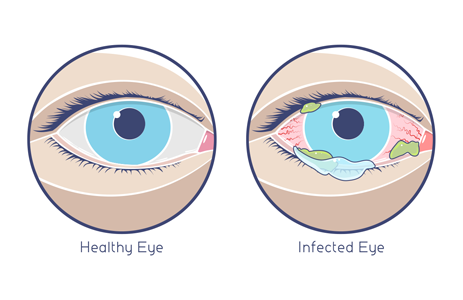
The symptoms may vary, but usually include:
- Redness or swelling of the white of the eye or inside the eyelids
- Increased amount of tears
- Eye discharge which may be clear, yellow, white, or green
- Itchy, irritated, and/or burning eyes
- Gritty feeling in the eye
- Crusting of the eyelids or lashes
- Contact lenses that feel uncomfortable and/or do not stay in place on the eye
There are four main causes of pink eye:
- Viruses
- Bacteria
- Allergens (like pet dander or dust mites)
- Irritants (like smog or swimming pool chlorine) that infect or irritate the eye and eyelid lining
It can be difficult to determine the exact cause of pink eye because some signs and symptoms may be the same no matter the cause. When pink eye is caused by a virus or bacteria, it is very contagious. It can spread easily and quickly from person to person (through contact with the discharge from the infected eye). Pink eye caused by allergens or irritants is not contagious.[9]
If a child has discharge from the eye, they should be excluded from care until they have been examine and cleared for re-admission by a health care provider “with or without treatment as determined by the health provider…They do not need to be sent home in the middle of the day. Children with conjunctivitis caused by allergies need not be excluded.”[10]
Fifth Disease (Slapped Cheek)
Fifth disease is a mild rash illness caused by parvovirus B19. It is more common in children than adults. A person usually gets sick with fifth disease within 14 days after getting infected with parvovirus B19.
The symptoms of fifth disease are usually mild and may include
- fever
- runny nose
- headache
- rash (on face and body)
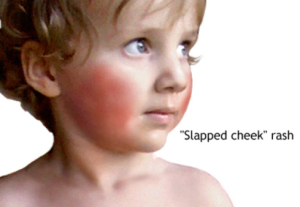
Parvovirus B19—which causes fifth disease—spreads through respiratory secretions, such as saliva, sputum, or nasal mucus, when an infected person coughs or sneezes. You are most contagious when it seems like you have “just a fever and/or cold” and before you get the rash or joint pain and swelling. After you get the rash you are not likely to be contagious. Fifth disease is usually mild and will go away on its own. Children and adults who are otherwise healthy usually recover completely.[12] “A child who has been diagnosed with fifth disease need not be excluded from child care.”[13]
Hand, Foot and Mouth Disease
Hand-foot-mouth disease is a common viral infection that most often begins in the throat. Hand-foot-mouth disease (HFMD) is most commonly caused by a virus called coxsackievirus A16. Children under age 10 are most often affected.
Symptoms of HFMD include:
- Fever
- Headache
- Loss of appetite
- Rash with very small blisters on the hands, feet, and diaper area that may be tender or painful when pressed
- Sore throat
- Ulcers in the throat (including tonsils), mouth, and tongue
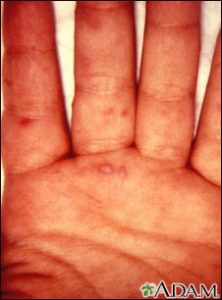
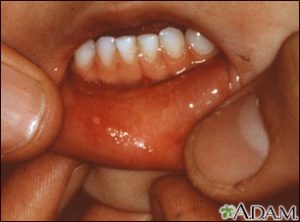
The virus can spread from person-to-person through tiny, air droplets that are released when the sick person sneezes, coughs, or blows their nose. You can catch hand-foot-mouth disease if:
A person with the infection sneezes, coughs, or blows their nose near you.
You touch your nose, eyes, or mouth after you have touched something contaminated by the virus, such as a toy or doorknob.
You touch stools or fluid from the blisters of an infected person.
The virus is most easily spread the first week a person has the disease. The time between contact with the virus and the start of symptoms is about 3 to 7 days. [16]
“Children with hand-foot-and-mouth disease do not need to stay home as long as they are feeling well enough to participate…Children with hand-foot-and-mouth disease usually do not need treatment and will get better on their own within a week.”[17]
Hepatitis A
Hepatitis A is a highly contagious liver infection caused by the hepatitis A virus. It can range from a mild illness lasting a few weeks to a severe illness lasting several months. Although rare, hepatitis A can cause death in some people.
What is the difference between hepatitis A, hepatitis B, and hepatitis C?
 |
Hepatitis A, hepatitis B, and hepatitis C are liver infections caused by three different viruses. Although each can cause similar symptoms, they have different modes of transmission and can affect the liver differently. Hepatitis A is usually a short-term infection and does not become chronic. Hepatitis B and hepatitis C can also begin as short-term, acute infections, but in some people, the virus remains in the body, resulting in chronic disease and long-term liver problems. There are vaccines to prevent hepatitis A and hepatitis B; however, there is no vaccine for hepatitis C.
|
Most children younger than age 6 do not have symptoms when they have hepatitis A. Older children and adults typically have symptoms. If symptoms develop, they usually start appearing 4 weeks after exposure, but can occur as early as 2 and as late as 7 weeks after exposure. Symptoms usually develop over a period of several days and can include:
- Fever
- Fatigue
- Loss of appetite
- Nausea
- Vomiting
- Abdominal pain
- Dark urine
- Diarrhea
- Clay-colored stools
- Joint pain
- Jaundice (yellowing of the skin and eyes)
Hepatitis A usually spreads when a person unknowingly ingests the virus from objects, food, or drinks contaminated by small, undetected amounts of stool from an infected person. A person can transmit the virus to others up to 2 weeks before symptoms appear.[18]
A child diagnosed with hepatitis A should be excluded from care until one week after the onset of symptoms.[19]
Impetigo
Impetigo is a common contagious skin infection that may be caused by two germs—Streptococcus pyogenes and Staphylococcus aureus. Recommended treatment depends on which germs are causing impetigo. With the right treatment, impetigo usually goes away within two to three weeks.
The signs of impetigo include red sores that pop easily and leave a yellow crust, fluid-filled blisters, itchy rash, skin lesions, and swollen lymph nodes. The sores can be uncomfortable and painful.
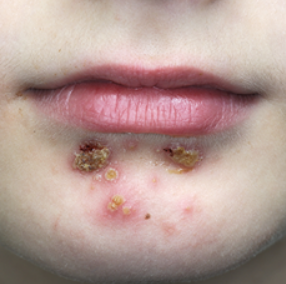
Impetigo is typically spread through skin-to-skin contact with an individual who has impetigo, but it can also be spread by contact with objects someone with impetigo has touched (for example, towels, blankets, and toys).
It is recommended that children with impetigo be excluded from care until 24 hours after treatment is started.[21]
Measles
Measles is a serious illness caused by a virus. The virus can last for one to two weeks. It is rare today because most children are immunized against it. However, the number of diagnosed cases has grown across the country. This increase is related to children not being vaccinated.
Measles starts with a fever that can get very high. Some of the other symptoms that may occur are:
- Fatigue
- Cough, runny nose, and red, watery eyes
- Rash of tiny, red spots that usually lasts five to six days, (the rash begins at the hairline, moves to the face and upper neck, and proceeds down the body)
- Diarrhea
- Ear infection
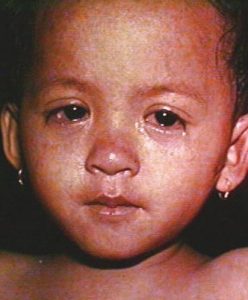
Measles spreads when a person infected with the measles virus breathes, coughs, or sneezes. It is very contagious from five days before until four days after the start of the rash. After exposure, it can take one to two weeks for the person to get sick.
Measles can spread by being in a room with a person with measles and up to two hours after that person is gone. It can also spread from an infected person even before they have a measles rash. Almost everyone who has not had the measles vaccine will get measles if they are exposed to the measles virus. People who have had measles or were immunized usually can’t catch it again.
Children diagnosed with measles should remain out of the center until a doctor determines the child is no longer infectious. Any unimmunized children or staff should be excluded from the program for two weeks after the rash appears in the last case of measles at the facility.[23]
Meningitis
Meningitis is inflammation of the thin tissue that surrounds the brain and spinal cord, called the meninges. There are several types of meningitis. The most common is viral meningitis. You get it when a virus enters the body through the nose or mouth and travels to the brain. Bacterial meningitis is rare, but can be deadly. It usually starts with bacteria that cause a cold-like infection. It can cause stroke, hearing loss, and brain damage. It can also harm other organs. Pneumococcal infections and meningococcal infections are the most common causes of bacterial meningitis.
Other rare forms of meningitis include, fungal meningitis, parasitic meningitis, amebic meningitis, and non-infectious meningitis.[24]
“Children with meningitis generally feel too ill to attend child care. They can return when they feel better with no fever, or when the health care provider determines the disease is no longer contagious.”[25]
Molluscum Contagiosum
Molluscum contagiosum is an infection caused by a poxvirus (molluscum contagiosum virus). The result of the infection is usually a benign, mild skin disease characterized by lesions (growths) that may appear anywhere on the body. Within 6-12 months, Molluscum contagiosum typically resolves without scarring but may take as long as 4 years.
The lesions, known as Mollusca, are small, raised, and usually white, pink, or flesh-colored with a dimple or pit in the center. They often have a pearly appearance. They’re usually smooth and firm. In most people, the lesions range from about the size of a pinhead to as large as a pencil eraser (2 to 5 millimeters in diameter). They may become itchy, sore, red, and/or swollen.
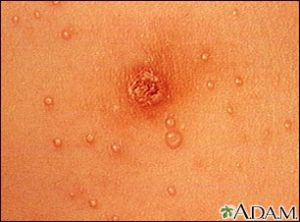
Mollusca may occur anywhere on the body including the face, neck, arms, legs, abdomen, and genital area, alone or in groups. The lesions are rarely found on the palms of the hands or the soles of the feet.[27]
“Children with this rash should not be excluded from ECE settings. Molluscum is a nuisance, not a serious health problem.”[28]
Mumps
Mumps is best known for the puffy cheeks and tender, swollen jaw that it causes. It is one of the diseases that is vaccine preventable. This is a result of swollen salivary glands under the ears on one or both sides, often referred to as parotitis.
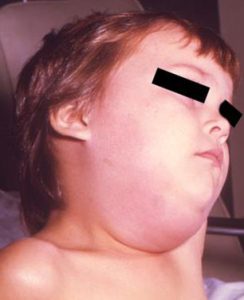
Other symptoms that might begin a few days before parotitis include:
- Fever
- Headache
- Muscle aches
- Tiredness
- Loss of appetite
Symptoms typically appear 16-18 days after infection, but this period can range from 12–25 days after infection.
Some people who get mumps have very mild symptoms (like a cold), or no symptoms at all and may not know they have the disease.
In rare cases, mumps can cause more severe complications.
Most people with mumps recover completely within two weeks.[30]
Mumps is a contagious disease caused by a virus. It spreads through direct contact with saliva or respiratory droplets from the mouth, nose, or throat. An infected person can likely spread mumps from a few days before their salivary glands begin to swell to up to five days after the swelling begins. A person with mumps should limit their contact with others during this time. For example, stay home from school and do not attend social events.[31]
Norovirus
Norovirus is the most common cause of vomiting and diarrhea, and foodborne illness.
The most common symptoms of norovirus are:
- diarrhea
- vomiting
- nausea
- stomach pain
Other symptoms includes fever, headache, and body aches.
Norovirus causes inflammation of the stomach or intestines. This is called acute gastroenteritis.
A person usually develops symptoms 12 to 48 hours after being exposed to norovirus. Most people with norovirus illness get better within 1 to 3 days.
If you have norovirus illness, you can feel extremely ill, and vomit or have diarrhea many times a day. This can lead to dehydration, especially in young children, older adults, and people with other illnesses.[32]
You can get norovirus by accidentally getting tiny particles of feces or vomit from an infected person in your mouth. This can happen through contaminated food and water, touching contaminated surfaces and then putting your fingers in the mouth, and having direct contact with someone that is infected with norovirus.
If you get norovirus illness, you can shed billions of norovirus particles that you can’t see without a microscope. Only a few norovirus particles can make other people sick. You are most contagious when you have symptoms of norovirus illness, especially vomiting, and during the first few days after you recover from norovirus illness.
However, studies have shown that you can still spread norovirus for two weeks or more after you feel better.[33] Children that are infected with norovirus should be excluded for 48 hours after becoming symptom free.[34]
Pertussis
Pertussis is a vaccine preventable respiratory illness commonly known as whooping cough. It is a very contagious disease caused by a type of bacteria called Bordetella pertussis. These bacteria attach to the cilia (tiny, hair-like extensions) that line part of the upper respiratory system. The bacteria release toxins (poisons), which damage the cilia and cause airways to swell.[35]
It can cause serious illness in babies, children, teens, and adults. Symptoms of pertussis usually develop within 5 to 10 days after you are exposed. Sometimes pertussis symptoms do not develop for as long as 3 weeks.
The disease usually starts with cold-like symptoms and maybe a mild cough or fever. In babies, the cough can be minimal or not even there. Babies may have a symptom known as “apnea.” Apnea is a pause in the child’s breathing pattern. Pertussis is most dangerous for babies. About half of babies younger than 1 year who get the disease need care in the hospital.
Early symptoms can last for 1 to 2 weeks and usually include:
- Runny nose
- Low-grade fever (generally minimal throughout the course of the disease)
- Mild, occasional cough
- Apnea – a pause in breathing (in babies)
Pertussis in its early stages appears to be nothing more than the common cold. Therefore, healthcare professionals often do not suspect or diagnose it until the more severe symptoms appear.
After 1 to 2 weeks and as the disease progresses, the traditional symptoms of pertussis may appear and include:
- Paroxysms (fits) of many, rapid coughs followed by a high-pitched “whoop” sound (babies with pertussis may not cough at all)
- Vomiting (throwing up) during or after coughing fits
- Exhaustion (very tired) after coughing fits
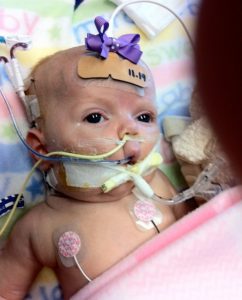
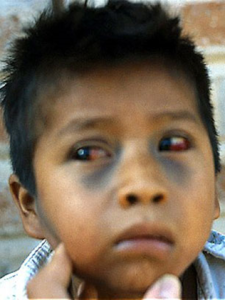
Pertussis can cause violent and rapid coughing, over and over, until the air is gone from your lungs. When there is no more air in the lungs, you are forced to inhale with a loud “whooping” sound. This extreme coughing can cause you to throw up and be very tired. Although you are often exhausted after a coughing fit, you usually appear fairly well in-between. Coughing fits generally become more common and bad as the illness continues, and can occur more often at night. The coughing fits can go on for up to 10 weeks or more.
Recovery from pertussis can happen slowly. The cough becomes milder and less common. However, coughing fits can return with other respiratory infections for many months after the pertussis infection started.[38]
Children who receive antibiotics should be excluded for 5 days of treatment. Children who do not receive treatment, should stay home for 21 days from the onset of symptoms.[39]
Pinworms
A pinworm (“threadworm”) is a small, thin, white roundworm (nematode) called Enterobius vermicularis that sometimes lives in the colon and rectum of humans. Pinworms are about the length of a staple. While an infected person sleeps, female pinworms leave the intestine through the anus and deposit their eggs on the surrounding skin.

Pinworm infection (called enterobiasis or oxyuriasis) causes itching around the anus which can lead to difficulty sleeping and restlessness. Symptoms are caused by the female pinworm laying her eggs. Symptoms of pinworm infection usually are mild and some infected people have no symptoms.
Pinworm infection often occurs in more than one person in household and institutional settings. Child care centers often are the site of cases of pinworm infection.
People become infected, usually unknowingly, by swallowing (ingesting) infective pinworm eggs that are on fingers, under fingernails, or on clothing, bedding, and other contaminated objects and surfaces. Because of their small size, pinworm eggs sometimes can become airborne and ingested while breathing.[41] Children and adults with a pinworm infection should be excluded only until their initial dose of treatment has begun.[42]
RSV
Respiratory syncytial (sin-SISH-uhl) virus, or RSV, is a common respiratory virus that usually causes mild, cold-like symptoms. Most people recover in a week or two, but RSV can be serious, especially for infants and older adults. In fact, RSV is the most common cause of bronchiolitis (inflammation of the small airways in the lung) and pneumonia (infection of the lungs) in children younger than 1 year of age in the United States. It is also a significant cause of respiratory illness in older adults.[43]
Symptoms of RSV infection usually include
- Runny nose
- Decrease in appetite
- Coughing
- Sneezing
- Fever
- Wheezing
These symptoms usually appear in stages and not all at once. In very young infants with RSV, the only symptoms may be irritability, decreased activity, and breathing difficulties.

RSV can also cause more severe infections such as bronchiolitis, an inflammation of the small airways in the lung, and pneumonia, an infection of the lungs. It is the most common cause of bronchiolitis and pneumonia in children younger than 1 year of age.
Almost all children will have had an RSV infection by their second birthday. People infected with RSV usually show symptoms within 4 to 6 days after getting infected. Most RSV infections go away on their own in a week or two.[45]
RSV can spread when an infected person coughs or sneezes. You can get infected if you get droplets from the cough or sneeze in your eyes, nose, or mouth, or if you touch a surface that has the virus on it, like a doorknob, and then touch your face before washing your hands. Additionally, it can spread through direct contact with the virus, like kissing the face of a child with RSV.
People infected with RSV are usually contagious for 3 to 8 days. However, some infants, and people with weakened immune systems, can continue to spread the virus even after they stop showing symptoms, for as long as 4 weeks. Children are often exposed to and infected with RSV outside the home, such as in school or child-care centers. They can then transmit the virus to other members of the family.
RSV can survive for many hours on hard surfaces such as tables and crib rails. It typically lives on soft surfaces such as tissues and hands for shorter amounts of time.[46]
“Frequently, a child is infectious before symptoms appear. Therefore, an infected child does not need to be excluded from child care unless he or she is not well enough to participate in usual activities.”[47]
Ringworm
Ringworm is a common skin infection that is caused by a fungus. It’s called “ringworm” because it can cause a circular rash (shaped like a ring) that is usually red and itchy. Anyone can get ringworm. The fungi that cause this infection can live on skin, surfaces, and on household items such as clothing, towels, and bedding.
Ringworm goes by many names. The medical terms are “tinea” or “dermatophytosis.” Other names for ringworm are based on its location on the body – for example, ringworm on the feet is also called “athlete’s foot.”[48]

Ringworm can affect skin on almost any part of the body as well as fingernails and toenails. The symptoms of ringworm often depend on which part of the body is infected, but they generally include:
- Itchy skin
- Ring-shaped rash
- Red, scaly, cracked skin
- Hair loss
Symptoms typically appear between 4 and 14 days after the skin comes in contact with the fungi that cause ringworm. [50]
The fungi that cause ringworm can live on skin and in the environment. There are three main ways that ringworm can spread:
- From a person who has ringworm
- From an animal that has ringworm.
- From the environment.[51]
“There is no need to exclude children/staff with these common, mild infections once treatment has been started. Refer persons with a suspicious rash to their health care providers for appropriate diagnosis and treatment and allow them to return as soon as treatment has begun.”[52]
Roseola
Roseola is a viral infection that commonly affects infants and young children. It involves a pinkish-red skin rash and high fever. Roseola is common in children ages 3 months to 4 years, and most common in those ages 6 months to 1 year. It is caused by a virus called human herpesvirus 6 (HHV-6), although similar syndromes are possible with other viruses.
The time between becoming infected and the beginning of symptoms (incubation period) is 5 to 15 days.
The first symptoms include:
- Eye redness
- Irritability
- Runny nose
- Sore throat
- High fever, that comes on quickly and may be as high as 105°F (40.5°C) and can last 3 to 7 days
About 2 to 4 days after becoming sick, the child’s fever lowers and a rash appears. This rash most often:
- Starts on the middle of the body and spreads to the arms, legs, neck, and face
- Is pink or rose-colored
- Has small sores that are slightly raised
The rash lasts from a few hours to 2 to 3 days. It usually does not itch.
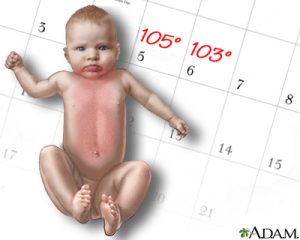
There is no specific treatment for roseola. The disease most often gets better on its own without complications.[54] “A child with fever and rash should be excluded from child care until seen by a health care provider. After the fever breaks, a child may return to care while the rash is still present, provided that the child feels well and is able to participate fully in all activities.”[55]
Rotavirus
Rotavirus is most common in your infants and young children. Children, even those who are vaccinated, may get infected and sick from rotavirus more than once. That is because neither natural infection with rotavirus nor vaccination provides full protection from future infections. Children who are not vaccinated usually have more severe symptoms the first time they get rotavirus disease. Vaccinated children are less likely to get sick from rotavirus.[56]
Symptoms usually start about 2 days after a person is exposed to rotavirus. Vomiting and watery diarrhea can last 3 to 8 days. Additional symptoms may include loss of appetite and dehydration (loss of body fluids), which can be especially dangerous for infants and young children.
Symptoms of dehydration include:
- decreased urination
- dry mouth and throat
- feeling dizzy when standing up
- crying with few or no tears and
- unusual sleepiness or fussiness.[57]
People who are infected with rotavirus shed the virus in their stool (poop). This is how the virus gets into the environment and can infect other people (through contaminated food, surfaces, or unwashed hands). People shed rotavirus the most, and are more likely to infect others, when they have symptoms and during the first 3 days after they recover. People with rotavirus can also infect others before they have symptoms.[58]
“Children with rotavirus should be excluded from child care if the stool cannot be contained by diapers or toilet use.”[59]
Rubella (German Measles)
Rubella is a vaccine preventable disease that is also called German measles, but it is caused by a different virus than measles.[60] It is usually mild with fever and a rash. About half of the people who get rubella do not have symptoms. If you do get them, symptoms may include
A rash that starts on the face and spreads to the body
- Mild fever
- Aching joints, especially in young women
- Swollen glands

Rubella spreads when an infected person coughs or sneezes. People without symptoms can still spread it. There is no treatment, but the measles-mumps-rubella (MMR) vaccine can prevent it.[62]
Shigella
Shigellosis is a very contagious diarrheal disease caused by bacteria called Shigella. Shigella causes about 500,000 cases of diarrhea in the United States annually.
Symptoms of the Shigella infection typically start one to two days after exposure and include:
- Diarrhea (sometimes bloody)
- Fever
- Abdominal pain
- A painful sensation of needing to pass stools even when bowels are empty
Shigella spreads when people put something in their mouths or swallow something that has come into contact with stool of a person infected with Shigella.
Exclusion is required for all diapered children whose stool is not contained in the diaper and toilet-trained children if the diarrhea is causing soiled clothing. Re-admission after diarrhea can occur when diapered children have their stool contained by the diaper (even if the stools remain loose) and when toilet-trained children are continent.[63]
Tuberculosis
Tuberculosis (TB) is a contagious disease, caused by the bacteria Mycobacterium tuberculosis. The bacteria usually attack the lungs, but can attack any organ in the body. Recommended treatment depends on whether a person has:
Latent TB infection–has no symptoms and can’t spread the TB bacteria to others; has potential to develop active TB disease if not treated
Active TB disease–has symptoms such as a fever, cough, or weight loss; these persons may be able to spread the germ to others. Needs treatment to cure the disease.
TB is spread in the air when a person with active TB disease of the lung or throat coughs, sneezes, or speaks. The germs can be inhaled by someone else and they can become infected. TB is often spread between people who spend time together every day. TB in children usually comes from being around adults with active TB disease.
Children and staff with active TB disease should be excluded from the Head Start or child care center until treatment is started, and the doctor determines the child or staff member is no longer infectious. All children and staff should be tested for TB infection if there has been an exposure to a person with active TB disease within the center or at home.[64]
[1] Image by the National Center for Emerging and Zoonotic Infectious Diseases, Division of Healthcare Quality Promotion is in the public domain
[2] Chest Cold (Acute Bronchitis) by the National Center for Emerging and Zoonotic Infectious Diseases, Division of Healthcare Quality Promotion is in the public domain
[3] About Chickenpox by the National Center for Immunization and Respiratory Diseases, Division of Viral Diseases is in the public domain
[4] Image by the Public Health Image Library (PHIL) is in the public domain
[5] Chickenpox (Varicella): Signs and Symptoms by the National Center for Immunization and Respiratory Diseases, Division of Viral Diseases is in the public domain
[6] Chickenpox (Varicella): Transmission by the National Center for Immunization and Respiratory Diseases, Division of Viral Diseases is in the public domain
[7] California Childcare Health Program. (2009). What Child Care Providers Should Know About…Chickenpox. University of California San Francisco. Retrieved from https://cchp.ucsf.edu/sites/g/files/tkssra181/f/ChickenPoxEN0509.pdf
[8] Image by the National Center for Immunization and Respiratory Diseases, Division of Viral Diseases is in the public domain
[9] Conjunctivitis (Pink Eye): Treatment by the National Center for Immunization and Respiratory Diseases, Division of Viral Diseases is in the public domain
[10] California Childcare Health Program. (2009). What Child Care Providers Should Know About…Conjunctivitis (Pink Eye). University of California San Francisco. Retrieved from https://cchp.ucsf.edu/sites/g/files/tkssra181/f/Conjunctivitis_0509.pdf
[11] Image by Medline Plus is in the public domain.
[12] Fifth Disease by the National Center for Immunization and Respiratory Diseases, Division of Viral Diseases is in the public domain
[13] California Childcare Health Program. (2009). What Child Care Providers Should Know About…Fifth Disease (Slapped Cheek Disease). University of California San Francisco. Retrieved from https://cchp.ucsf.edu/sites/g/files/tkssra181/f/Fifth%20Disease_0509.pdf
[14] Image by Medline Plus is in the public domain.
[15] Image by Medline Plus is in the public domain.
[16] Hand-Foot-Mouth Disease by MedlinePlus is in the public domain
[17] California Childcare Health Program. (2009). What Child Care Providers Should Know About…Hand-Foot-and-Mouth Disease (Coxsackie Virus A16). University of California San Francisco. Retrieved from https://cchp.ucsf.edu/sites/g/files/tkssra181/f/HandFootMouth_0509.pdf
[18] Hepatitis A Questions and Answers for the Public by the National Center for HIV/AIDS, Viral Hepatitis, STD, and TB Prevention is in the public domain
[19] California Childcare Health Program. (2009). What Child Care Providers Should Know About…Hepatitis A. University of California San Francisco. Retrieved from https://cchp.ucsf.edu/sites/g/files/tkssra181/f/Hepatitis_A_EN_0509.pdf
[20] Image by MedlinePlus is in the public domain
[21] Impetigo by Head Start Early Childhood Learning & Knowledge Center is in the public domain
[22] Image by the Public Health Image Library is in the public domain
[23] Measles by Head Start Early Childhood Learning & Knowledge Center is in the public domain
[24] Meningitis by the National Center for Immunization and Respiratory Diseases is in the public domain
[25] California Childcare Health Program. (2009). What Child Care Providers Should Know About…Meningitis. University of California San Francisco. Retrieved from https://cchp.ucsf.edu/sites/g/files/tkssra181/f/Meningitis_0509.pdf
[26] Molluscum Contagiosum – Close-Up of the Chest by Medline Plus is in the public domain.
[27] Molluscum Contagiosum by the National Center for Emerging and Zoonotic Infectious Diseases, Division of High-Consequence Pathogens and Pathology is in the public domain
[28] California Childcare Health Program. (2009). What Child Care Providers Should Know About…Molluscum Contagiosum. University of California San Francisco. Retrieved from. https://cchp.ucsf.edu/sites/g/files/tkssra181/f/MolluscumContgiosumEN_0909.pdf
[29] Image by the Public Health Image Library (PHIL) is in the public domain
[30] Signs & Symptoms of Mumps by the National Center for Immunization and Respiratory Diseases, Division of Viral Diseases is in the public domain
[31] Transmission of Mumps by the National Center for Immunization and Respiratory Diseases, Division of Viral Diseases is in the public domain
[32] The Symptoms of Norovirus by the National Center for Immunization and Respiratory Diseases, Division of Viral Diseases is in the public domain
[33] How Norovirus Spreads by the National Center for Immunization and Respiratory Diseases, Division of Viral Diseases is in the public domain
[34] Thunder Bay District Health Unit. (2017). Common childhood infections – A guide for principals, teachers and child care providers. Thunder Bay District Health Unit. Retrieved from https://www.tbdhu.com/sites/default/files/files/resource/2017-03/Common%20Childhood%20Infections%20Manual_0.pdf
[35] Pertussis (Whooping Cough): Causes and Transmission by the National Center for Immunization and Respiratory Diseases, Division of Bacterial Diseases is in the public domain
[36] Image by the National Center for Immunization and Respiratory Diseases, Division of Bacterial Diseases is in the public domain
[38] Pertussis (Whooping Cough): Signs and Symptoms by the National Center for Immunization and Respiratory Diseases, Division of Bacterial Diseases is in the public domain
[39] Thunder Bay District Health Unit. (2017). Common childhood infections – A guide for principals, teachers and child care providers. Thunder Bay District Health Unit. Retrieved from https://www.tbdhu.com/sites/default/files/files/resource/2017-03/Common%20Childhood%20Infections%20Manual_0.pdf
[40] Image by DPDx – Laboratory Identification of Parasites of Public Health Concern and the Public Health Image Library (PHIL) is in the public domain
[41] Pinworm Infection FAQs by CDC Global Health, Division of Parasitic Diseases is in the public domain
[42] California Childcare Health Program. (2009). What Child Care Providers Should Know About…Pinworms. University of California San Francisco. Retrieved from https://cchp.ucsf.edu/sites/g/files/tkssra181/f/Pinworms_0509.pdf
[43] Respiratory Syncytial Virus Infection (RSV) by the National Center for Immunization and Respiratory Diseases, Division of Viral Diseases is in the public domain
[44] Image by Philippe Put is licensed under CC BY 2.0
[45] Respiratory Syncytial Virus Infection (RSV): Symptoms and Care by the National Center for Immunization and Respiratory Diseases, Division of Viral Diseases is in the public domain
[46] RSV Transmission by the National Center for Immunization and Respiratory Diseases, Division of Viral Diseases is in the public domain
[47] California Childcare Health Program. (2009). What Child Care Providers Should Know About…Respiratory Syncytial Virus (RSV) in the Child Care Setting. University of California San Francisco. Retrieved from https://cchp.ucsf.edu/sites/g/files/tkssra181/f/RSV_0910.pdf
[48] Ringworm by the National Center for Emerging and Zoonotic Infectious Diseases, Division of Foodborne, Waterborne, and Environmental Diseases is in the public domain
[49] Images by the National Center for Emerging and Zoonotic Infectious Diseases, Division of Foodborne, Waterborne, and Environmental Diseases is in the public domain
[50] Symptoms of Ringworm Infections by the National Center for Emerging and Zoonotic Infectious Diseases, Division of Foodborne, Waterborne, and Environmental Diseases is in the public domain
[51] Sources of Infection by the National Center for Emerging and Zoonotic Infectious Diseases, Division of Foodborne, Waterborne, and Environmental Diseases is in the public domain
[52] California Childcare Health Program. (2009). What Child Care Providers Should Know About…Ringworm (Tinea). University of California San Francisco. Retrieved from https://cchp.ucsf.edu/sites/g/files/tkssra181/f/Ringworm_0509.pdf
[53] Image by MedlinePlus is in the public domain.
[54] Roseola by MedlinePlus is in the public domain
[55] California Childcare Health Program. (2009). What Child Care Providers Should Know About…Roseola (Sixth Disease). University of California San Francisco. Retrieved from https://cchp.ucsf.edu/sites/g/files/tkssra181/f/Roseola_0509.pdf
[56] Rotavirus: Transmission by the National Center for Immunization and Respiratory Diseases, Division of Viral Diseases is in the public domain
[57] Rotavirus: Symptoms by the National Center for Immunization and Respiratory Diseases, Division of Viral Diseases is in the public domain
[58] Rotavirus: Transmission by the National Center for Immunization and Respiratory Diseases, Division of Viral Diseases is in the public domain
[59] California Childcare Health Program. (2009). What Child Care Providers Should Know About…Rotavirus Infections. University of California San Francisco. Retrieved from https://cchp.ucsf.edu/sites/g/files/tkssra181/f/RotavirusEN0509.pdf
[60] Rubella (German Measles) Vaccination by the National Center for Immunization and Respiratory Diseases is in the public domain
[61] Image by the Public Health Image Library (PHIL) is in the public domain
[62] Rubella by MedlinePlus is in the public domain
[63] Shigella by Head Start Early Childhood Learning & Knowledge Center is in the public domain
[64] Tuberculosis by Head Start Early Childhood Learning & Knowledge Center is in the public domain
